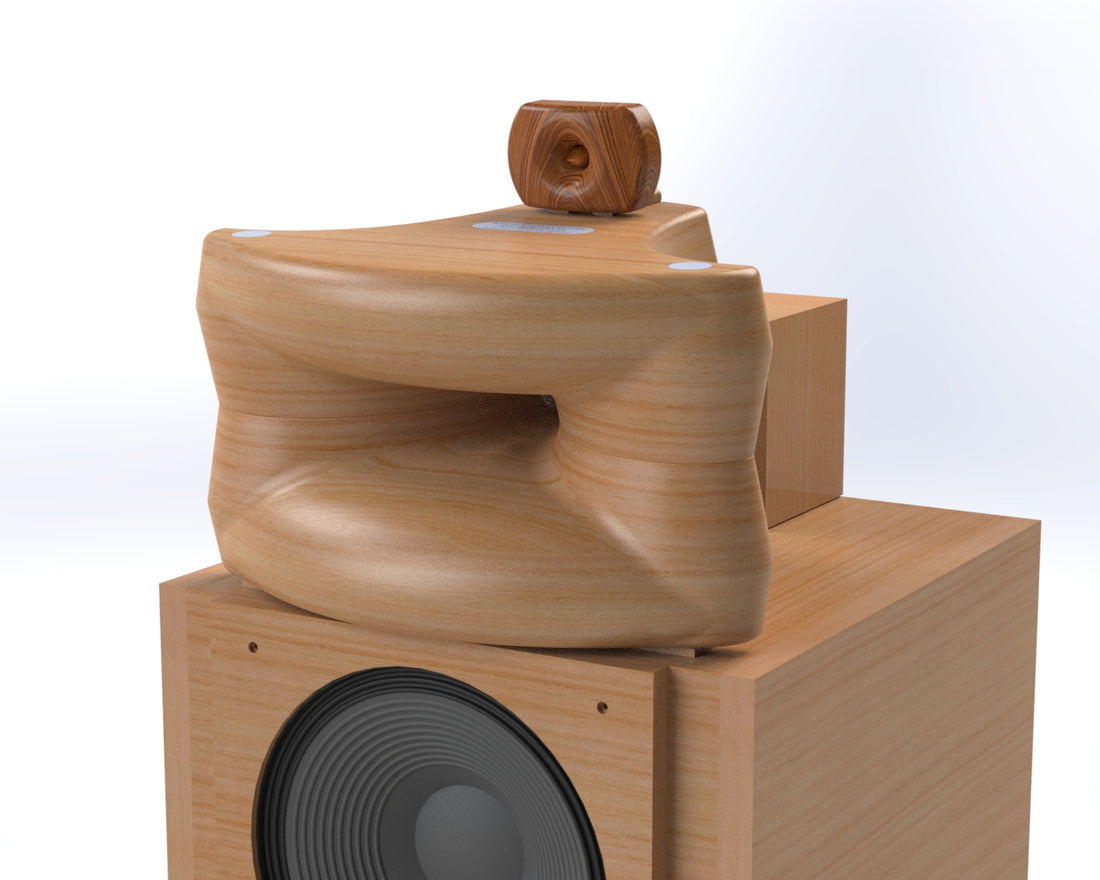

In this blog post I test a newly developed horn lens for the Fostex T900A super tweeter. I purchased these tweeters with the goal of improving the sound quality by replacing the existing front horn lens with my own design which uses my ES horn flare curvature.

Considerable effort was placed on ensuring the new lens achieved its design goals. The lens follows the same geometry as the stock tweeter directly in front of the diaphragm. This took considerable effort to ensure that the accuracy was maintained during CNC machining the component. Special setups were required to achieve this geometry accurately.

The 

Below you can see the precision CNC'd features required for proper physical fitment of the assembly to the tweeter body. 
Below you can see the extension which fills the area directly in front of the diaphragm to help with acoustical loading.


Shown below is the raw wood before finishing. It should come out looking quite beautiful with a few coats of wax. We carefully hand picked walnut that had high contrast and striking wood grain.



The cradle features located the stock dowels for the T900A providing accurate and stable locating.

I recessed the bottom of the horn lens to accommodate the stock T900A dowels. This helped support the tweeter/horn assembly's center of gravity.



Shown below are the stock T900A used to support the tweeter.

Production is complete on two pairs.

Below are some renders for a project we are currently working on. Cabinet No.2183.1 is a back loaded horn for the Supravox 380-EXC field coil woofer. Sitting on top is a custom ES-450 biradial (No.2183.2) using the B&C DCM50 2" large format midrange compression driver. We've integrated the T900A + Horn Lens No.2258 into the top of the 2183.2 horn which positions the super tweeter for proper physical time alignment. The 2183 horn sits on three rubber balls and provides 3 degrees of downward tilt for optimal listening height.





Alternatively the horn rendered in birch wood.

Shown at the rear is are the locating grooves for the super tweeter. You can also see the B&C DCM50 modelled. 
Measurements
I began by comparing the impedance sweep between the stock tweeter and the modified tweeter with the 2258 lens installed. Below is an overlay of the impedance and phase response with the 2258 lens in green for both the phase and impedance. The red and blue curve is the stock tweeter.
If we zoom in on the area of concern we can see clearly the affect of the new lens. We see a flatter phase response with the new lens. We see a flatter impedance sweep in the 7-10kHz region (less angle) which means a less reactive load to the amplifier.


Frequency Response
Below is an overlay of the frequency response with the stock tweeter in red.

The stock tweeter has a -5dB dip centered around 8kHz.

We saw better loading in the impedance sweep in this region which we can see the effect on much better frequency response through this region.
We also see the superior loading continue into the 12kHz region providing 2.2dB more sensitivity. This will result in less distortion for this region.

Generally we see a nearly perfect linear response on par with the best I've seen.
Off-Axis Performance
Below is the off-axis frequency response for 0°,15°,30°
& 45°off-axis for the stock tweeter.

The 8kHz lack any sort of pattern control.

We can see this off-axis colored polar map where the power response into the room is very concentrated around the 8kHz region.

We see a sharp narrowing of directivity as we move into the upper treble.

Horn Lens No.2258
Below is the off-axis frequency response for 0°,15°,30°
& 45°off-axis for the T900A with the 2258 Lens.

Zooming in on the area of interest, the response is much more consistent off-axis.

The colored polar map.

If we put the two polar maps together we can easily observe any differences. The polar map on the bottom half is the 2258 lens while the top half is the stock tweeter.

Time Domain Aspect
I began by looking at the step response of the stock tweeter.

I then measured the step response on the T900A with the 2258 lens.

Below is the CSD plot for the stock tweeter.

Below is the CSD plot for the T900A with horn lens No.2258.

Below is the burst decay for the stock tweeter.

Below is the burst decay for the T900A with horn lens No.2258.

Distortion
Below is the intermodulation distortion for the stock tweeter using an 85dB test signal at 1m. IMD is -65dB for the 10kHz region.

Below is the IMD for the T900A with horn lens No.2258. IMD is -71dB for the 10kHz region.

Conclusion
Horn lens No.2258 achieves its design goals. These goals are summarized below.
- Smoother frequency response
- Even power response off-axis
- Faster decay times in the time domain
- Lower distortion
- Higher sensitivity


